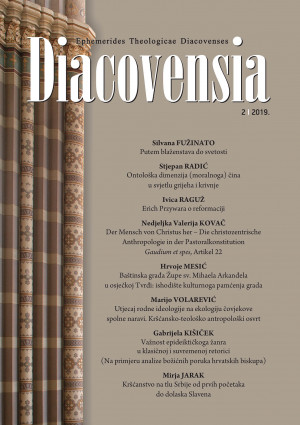Baštinska građa Župe sv. Mihaela Arkanđela u osječkoj Tvrđi: ishodište kulturnoga pamćenja grada
Cultural Heritage Materials of St. Michael the Archangel’s Parish Church in the Osijek Tvrđava (Fortress): The Source of the City’s Cultural Memory
Author(s): Hrvoje MesićSubject(s): Cultural history, Museology & Heritage Studies, History of Church(es), Local History / Microhistory
Published by: Katolički bogoslovni fakultet u Đakovu
Keywords: parish archives; the Inner City; memory figures; digital convergence; cataloguing; the city memory; cultural heritage;
Summary/Abstract: The identity of Tvrđa (Fortress) consists of memory collections of cultural and historical identities preserved in heritage institutions. The work of heritage institutions in the area of public memory is to embody spatial and symbolic engagement of an open city and a society. Heritage institutions occupy a central position in the cultural and technological convergence that is identified in three main trends: digital convergence, digital communication and digital responsibility. It is important to ensure visibility and availability of materials kept within the invisible and closed spaces of Tvrđa using the modern information technology and the process of digitalization. Such is the archive of St. Michael the Archangel’s Parish Church within the Osijek Tvrđa which is being deliberately neglected as a carrier of cultural identity. It is a place of recollection where the notions of history, past and tradition are being materialized and stored. The parish archival materials are a first-class historical source for understanding the city’s civic and religious life and for creating a cultural image of the area from the end of the 19th and the first half of the 20th century. The process of digital convergence and cataloguing will use photographs, a memorial, obituaries and archival documents which define the city as a document. Cultural heritage materials will be digitalized and catalogued according to the international Cataloging Cultural Objects (CCO) standard together with the accompanying descriptive and administrative metadata. The CCO standard not only provides guidelines for describing objects of cultural heritage but can also serve as a model for organizing information and creating a relational database in church archives preserving cultural heritage. This paper will prove and conclude that the archive of St. Michael’s Parish Church is a heritage institution, i.e. the source of cultural memory of the area and the keeper of personal and collective identity of the Osijek Inner City.
Journal: Diacovensia: teološki prilozi
- Issue Year: 27/2019
- Issue No: 2
- Page Range: 285-305
- Page Count: 21
- Language: Croatian

